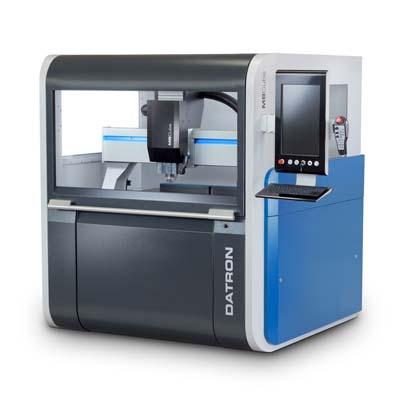
DATRON Dynamics has launched the M8 Cube, a "next generation" German-engineered, high-speed machining center designed for greater speed, accuracy and industrial durability. DATRON's main objective in the design of the M8 Cube was to reduce the number of parts, overall cost, and ultimately to simplify both service and support. Brushless, direct drives provide faster acceleration, feed rates up to 866 inches per minute and shorter cycle times. A 3kW, 40,000 RPM, liquid-chilled spindle delivers greater horsepower for heavier machining, as well as the flexibility to mill a wide range of materials. HSK-E 25 tool holders offer precision and less than 1µm run out.
At a time when shop floor space is at a premium, the M8 Cube has a footprint of only 69" x 69". At the same time, it features a large work area of 40" x 28" x 9" (X,Y,Z). This allows for multiple setups and accommodates DATRON's integrated work-holding systems, automation and rotary axes – all combined and configured to meet the exact needs of the manufacturer.
The M8 Cube is controlled by a dynamic Windows-based software that has the flexibility to integrate with third-party software and automation systems. Operation indicator lights built in to the gantry and control provide visible machine status eliminating the need for additional light sticks. Other options include a spray-mist coolant system, integrated 3D probing and automatic toolchangers with up to 30 stations and tool-length sensing. The M8 Cube is ideal for precision, high or low volume production of electronic, aerospace and medical parts, as well as industrial engraving applications.
Contact Details
Related Glossary Terms
- coolant
coolant
Fluid that reduces temperature buildup at the tool/workpiece interface during machining. Normally takes the form of a liquid such as soluble or chemical mixtures (semisynthetic, synthetic) but can be pressurized air or other gas. Because of water’s ability to absorb great quantities of heat, it is widely used as a coolant and vehicle for various cutting compounds, with the water-to-compound ratio varying with the machining task. See cutting fluid; semisynthetic cutting fluid; soluble-oil cutting fluid; synthetic cutting fluid.
- feed
feed
Rate of change of position of the tool as a whole, relative to the workpiece while cutting.
- inches per minute ( ipm)
inches per minute ( ipm)
Value that refers to how far the workpiece or cutter advances linearly in 1 minute, defined as: ipm = ipt 5 number of effective teeth 5 rpm. Also known as the table feed or machine feed.
- machining center
machining center
CNC machine tool capable of drilling, reaming, tapping, milling and boring. Normally comes with an automatic toolchanger. See automatic toolchanger.
- milling machine ( mill)
milling machine ( mill)
Runs endmills and arbor-mounted milling cutters. Features include a head with a spindle that drives the cutters; a column, knee and table that provide motion in the three Cartesian axes; and a base that supports the components and houses the cutting-fluid pump and reservoir. The work is mounted on the table and fed into the rotating cutter or endmill to accomplish the milling steps; vertical milling machines also feed endmills into the work by means of a spindle-mounted quill. Models range from small manual machines to big bed-type and duplex mills. All take one of three basic forms: vertical, horizontal or convertible horizontal/vertical. Vertical machines may be knee-type (the table is mounted on a knee that can be elevated) or bed-type (the table is securely supported and only moves horizontally). In general, horizontal machines are bigger and more powerful, while vertical machines are lighter but more versatile and easier to set up and operate.
